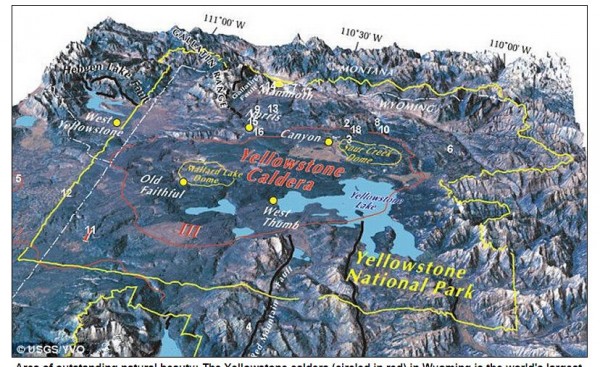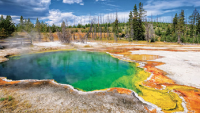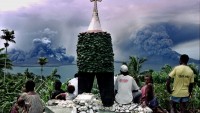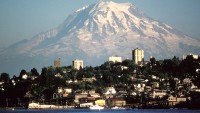Eruption of the Yellowstone Supervolcano will turn the U.S. into a Third World Country Overnight
| Arthur Dominic Villasanta | | Sep 01, 2014 03:25 AM EDT |
(Photo : USGS) Location of the Yellowstone supervolcano
First the good news. The worst case scenario for an eruption of the massive supervolano beneath the Yellowstone National Park in Wyoming isn't as bad as first thought.
Now, the bad news. Even this new estimate shows the eruption of the Yellowstone supervolcano will still destroy at least two-thirds of the United States of America as we know it.
Like Us on Facebook
Game over for the former USA.
Another piece of good news is that this inevitable eruption won't come in our lifetime. But it will occur, and scientists estimate this could come to pass in about a million years, give or take a few hundred thousand years.
What many Americans, especially those living out West, don't realize is that they're on top of the world's largest volcano.
The floor of the supervolcano beneath Yellowstone National Park has been climbing three inches per year since 2008, the fastest rate since records began in 1923.
"It's an extraordinary uplift, because it covers such a large area and the rates are so high," said Bob Smith from the University of Utah, an expert in Yellowstone's volcanism:
"At the beginning we were concerned it could be leading up to an eruption."
He said the best evidence among scientists is that the crustal magma chamber is filling with molten rock.
Some 400 miles beneath Yellowstone is a magma 'hotspot' that rises to 30 miles underground and extends over an area of 300 miles. Atop this, but still beneath the surface, sits the still dormant Yellowstone supervolcano.
Here's what our descendants can expect to see when Yellowstone does blow-up.
When it explodes, the supervolcano will hurl lava into the sky for thousands of feet and dump a layer of volcanic ash 10 feet deep up to 1,000 miles away. Most of the U.S. will be covered by an even thicker layer of ash that will kill most plant life.
Two-thirds of the U.S. will become immediately uninhabitable.
Some experts believe the next Yellowstone eruption will be a planet-killing cataclysm that could wipe out practically all life on Earth. Humans will be among the first species to go extinct.
Fears, mostly unfounded, about a Yellowstone eruption were fueled by recent news reports that computer simulations show this catastrophe occurring earlier than anticipated.
This nightmarish news forced the U.S. Geological Survey to confirm the situation won't be as bad as had first been predicted.
USGS said a ground breaking computer simulation named "Ash3D" has been used to study the effects of a future Yellowstone volcanic eruption.
Based on the data provided by the simulation, USGS said the impact of an eruption by the Yellowstone supervolcano might be much less compared to earlier estimates.
USGS said the chance of Yellowstone exploding in the coming centuries is very low.
The situation, however, can change if there's a major earthquake that shifts eological plates close to the area. The dangerous San Andreas Fault in California is only a few hundred kilometers away.
The Yellowstone caldera has erupted three times in the last 2.1 million years. It last erupted 600,000 years ago.
The caldera covers a 25 mile x 37 mile (40 kilometer x 60 kilometer) portion of Wyoming. The caldera is a crater formed after the last big Yellowstone blast 640,000 years ago.
Technically, a caldera is the low rim left behind when a large volcano collapses in upon itself after a series of enormous eruptions.
TagsEruption of Yellowstone Supervolcano, SuperVolcano, Yellowstone Supervolcano, Yellowstone National Park Volcano
©2015 Chinatopix All rights reserved. Do not reproduce without permission
EDITOR'S PICKS
-

Did the Trump administration just announce plans for a trade war with ‘hostile’ China and Russia?
-

US Senate passes Taiwan travel bill slammed by China
-

As Yan Sihong’s family grieves, here are other Chinese students who went missing abroad. Some have never been found
-

Beijing blasts Western critics who ‘smear China’ with the term sharp power
-

China Envoy Seeks to Defuse Tensions With U.S. as a Trade War Brews
-

Singapore's Deputy PM Provides Bitcoin Vote of Confidence Amid China's Blanket Bans
-

China warns investors over risks in overseas virtual currency trading
-

Chinese government most trustworthy: survey
-

Kashima Antlers On Course For Back-To-Back Titles
MOST POPULAR
LATEST NEWS
Zhou Yongkang: China's Former Security Chief Sentenced to Life in Prison

China's former Chief of the Ministry of Public Security, Zhou Yongkang, has been given a life sentence after he was found guilty of abusing his office, bribery and deliberately ... Full Article
TRENDING STORY

China Pork Prices Expected to Stabilize As The Supplies Recover

Elephone P9000 Smartphone is now on Sale on Amazon India

There's a Big Chance Cliffhangers Won't Still Be Resolved When Grey's Anatomy Season 13 Returns

Supreme Court Ruled on Samsung vs Apple Dispute for Patent Infringement

Microsoft Surface Pro 5 Rumors and Release Date: What is the Latest?













